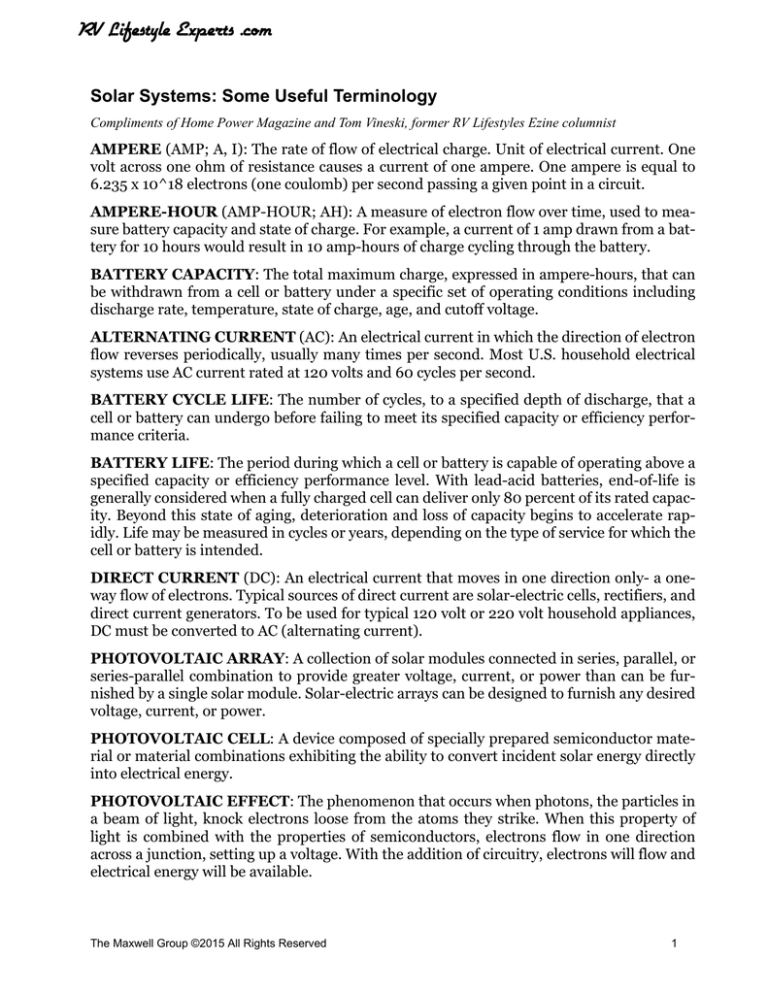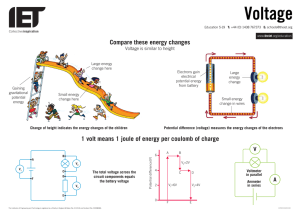
RV Lifestyle Experts .com
Solar Systems: Some Useful Terminology
Compliments of Home Power Magazine and Tom Vineski, former RV Lifestyles Ezine columnist
AMPERE (AMP; A, I): The rate of flow of electrical charge. Unit of electrical current. One
volt across one ohm of resistance causes a current of one ampere. One ampere is equal to
6.235 x 10^18 electrons (one coulomb) per second passing a given point in a circuit.
AMPERE-HOUR (AMP-HOUR; AH): A measure of electron flow over time, used to measure battery capacity and state of charge. For example, a current of 1 amp drawn from a battery for 10 hours would result in 10 amp-hours of charge cycling through the battery.
BATTERY CAPACITY: The total maximum charge, expressed in ampere-hours, that can
be withdrawn from a cell or battery under a specific set of operating conditions including
discharge rate, temperature, state of charge, age, and cutoff voltage.
ALTERNATING CURRENT (AC): An electrical current in which the direction of electron
flow reverses periodically, usually many times per second. Most U.S. household electrical
systems use AC current rated at 120 volts and 60 cycles per second.
BATTERY CYCLE LIFE: The number of cycles, to a specified depth of discharge, that a
cell or battery can undergo before failing to meet its specified capacity or efficiency performance criteria.
BATTERY LIFE: The period during which a cell or battery is capable of operating above a
specified capacity or efficiency performance level. With lead-acid batteries, end-of-life is
generally considered when a fully charged cell can deliver only 80 percent of its rated capacity. Beyond this state of aging, deterioration and loss of capacity begins to accelerate rapidly. Life may be measured in cycles or years, depending on the type of service for which the
cell or battery is intended.
DIRECT CURRENT (DC): An electrical current that moves in one direction only- a oneway flow of electrons. Typical sources of direct current are solar-electric cells, rectifiers, and
direct current generators. To be used for typical 120 volt or 220 volt household appliances,
DC must be converted to AC (alternating current).
PHOTOVOLTAIC ARRAY: A collection of solar modules connected in series, parallel, or
series-parallel combination to provide greater voltage, current, or power than can be furnished by a single solar module. Solar-electric arrays can be designed to furnish any desired
voltage, current, or power.
PHOTOVOLTAIC CELL: A device composed of specially prepared semiconductor material or material combinations exhibiting the ability to convert incident solar energy directly
into electrical energy.
PHOTOVOLTAIC EFFECT: The phenomenon that occurs when photons, the particles in
a beam of light, knock electrons loose from the atoms they strike. When this property of
light is combined with the properties of semiconductors, electrons flow in one direction
across a junction, setting up a voltage. With the addition of circuitry, electrons will flow and
electrical energy will be available.
The Maxwell Group ©2015 All Rights Reserved
1
PHOTOVOLTAIC MODULE: A PV module consists of series and/or parallel wired
cells typically made from layered silicon crystals that convert light energy to DC electricity. The number of modules in a given system varies depending on the combined load
being powered.
VOLT (V): The volt is the unit used in the measurement of electromotive force (electrical
“pressure”). A standard electrical definition of the volt is: an electromotive force of 1 volt
is necessary to move a current of 1 ampere through a 1 ? resistor. It is often also referred
to as electrical potential difference or potential difference.
VOLTAGE: A measure of the force or “push” given the electrons in an electrical circuit;
a measure of electrical potential. Analogy: pressure in a water pipe. AKA Potential.
VOLTAGE DROP: Loss of voltage (electrical pressure) caused by the resistance in wire
and electrical devices. Proper wire sizing will minimize voltage drop, particularly over
long distances. Voltage drop is determined by four factors: wire size, current (amps),
voltage, and length of wire. Water analogy: friction loss in pipe.
VOLTAGE, PEAK POWER POINT (Vpp): The voltage at which a photovoltaic module or array generates at the highest power (watts). A 12 volt nominal PV module will typically have a peak power voltage of around 17 volts. A PV array-direct solar pump should
reach this voltage in full sun conditions. In a higher voltage array, it will be a multiple of
this voltage.
WATT: Unit of power. Power is the rate of generating or using energy. One watt is the
power developed or dissipated in a one volt circuit in which there is a current of one
ampere (6.28 million million electrons per second). Watts = amps X volts.
WATT-HOUR: A unit of measurement quantifying an amount of energy used or generated. A load that consumes 1 watt for 10 hours uses 10 watt-hours.
The Maxwell Group ©2015 All Rights Reserved
2





